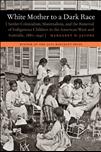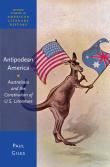AustLit
-
It is worth noting that comparative scholarship dedicated to the US and Australia is increasingly becoming more common even if, as Paul Giles wrote in Antipodean America : Australasia and the Constitution of U.S. Literature in 2013, the critical moment has been overly long in arriving. Looking at themes as varied as maternalism, ecopastoralism, and the pioneer figure as a chronotope, Margaret D. Jacobs, Tom Lynch, and Tony Hughes-d'Aeth have all produced scholarship within the last decade examining narrative similarities in the settler literatures of the US and Australia. In White Mother to a Dark Race : Settler Colonialism, Maternalism, and the Removal of Indigenous Children in the American West and Australia, 1880-1940, Jacobs argued that “it would be a mistake to fall under the spell of nationalist narratives of exceptionalism that ignore a common set of relationships that developed in each place between incoming settlers, many of them of Anglo-Celtic origin, and indigenous peoples” (11). In other words, treating the literatures of the US and Australia primarily as bodies of a distinctly national literature overlooks their entangled colonial origins and, worse, passively assumes that one or both nations are now “post-colonial” and Indigenous sovereignty is a non-issue.
Of course, settler colonialism has occurred in several places other than the US and Australia, and relationships between settlers and Indigenous populations feature prominently in their literatures, as well. The more obvious choices for comparative study might be between Australia and New Zealand or between the US, Hawaii, and/or Canada given their respective geographic proximity, cultural similarities, or interrelated national histories. And, to be sure, there are important differences in the colonial histories of the US and Australia. Robert Hughes notes that Australia is unique in that no other colony has ever been conceived of firstly and entirely as a penal colony, nor has a colony ever been established so far from the metropole. He also notes that their colonial timelines don't buttress together perfectly: by the time Captain James Cook “discovered” Botany Bay near present-day Sydney in 1770, American patriots Paul Revere and Samuel Adams were calling for rebellion from English rule. The eventual transition from British colony to federal independence occurred under markedly different circumstances for the US than it did for Australia, which was granted commonwealth status by the British Parliament in 1901 but remained constitutionally aligned with the United Kingdom up until 1986.
Furthermore, the fact that racism is nuanced differently in the US than it is in Australia underscores the need for contextual specificity in comparative settler criticism. Because it is a means of organising people into roles that make governing possible, race is a feature of all settler colonial projects; however, notions of racism vary from one settler polity to the next. Wolfe explains, for example, that while US settler colonialism creates important legal and social distinctions between blackness and indigeneity, Australian settler colonialism conflates them so that to be Indigenous is also to be black. Indeed, in "Being or Nothingness: Indigeneity, Antiblackness, and Settler Colonial Critique" (2015) Iyko Day makes the compelling argument that anti-indigeneity and anti-blackness are two distinct but co-constitutive forms of racial prejudice in the US settler colonial paradigm, which is propped up by the erasure of Indigenous presences, the exploitation of African and African-American labour, and the interpretation of white supremacy as the right to possession over land, bodies, and the nation.
Yet, despite their differences as distinct nations, the US and Australia share similar and sometimes overlapping modes of producing literary narratives, which, I suggest, supports the belief that settler polities share a fundamental need to construct and sustain an threatened sense of belonging in their respective colonised lands. As a collective, settlers experience several related anxieties over belonging, among them, a fear of being subject to the same kind of conquering violence that enabled their own settlement and tension over their indigenous authenticity in settled lands. Further, Ghassan Hage argues that, even as whiteness was made synonymous with civilisation in settler social hierarchies, persistent tensions emerged that had settlers asking if they were white enough to belong and fearing that the privileges of their whiteness would be revoked (see Against Paranoid Nationalism : Searching for Hope in a Shrinking Society).
Not surprisingly, these concerns are regularly articulated in narratives about the past and future of settler sovereignty. In the US, the relationships between settlers’ colonial ancestors, enslaved Africans and African Americans, and Indigenous populations represent an ambivalent or shameful past of dispossession and oppression through European colonisation that is often jettisoned in favour of the romantic pioneer mythos. At the same time, the relationships between settler and (im)migrant populations—Central and South Americans in the US, West and Southeast Asians in Australia, and peoples from all Islamic nations in both—represent an uncertain or fearful future of displacement through foreign immigration coded as invasion.
Juxtaposing settler-centred narratives from these two nations reveals that, even as the specific stories often diverge in form and genre, they share certain essential tenets: that settlers symbolically appropriate Indigeneity as they dispossess Indigenous peoples of their lands; that their sense of belonging emerges out of a possessive logic over not only land but also culturally valuable identity markers such as gender and race; and that they imagine their sense of belonging to be constantly under threat, either from within their newfound homeland (by “Indians”) or from without it (by “foreigners”). In my work, I use the term settler nativism to identify the double register of contemporary settler belonging in the US and Australia, which is marked by the ongoing pursuit of indigenisation (the settler-as-native) and the consistent apprehension over immigration (the settler-as-nativist).
Preferred MLA citation for use of the above intellectual property:
Franks, Travis. "Why Relational Criticism on Settler Literatures of Australia and the US?" Settler Literature: Resources for Students and Teachers. AustLit Database. 2017.
-
-
 Image courtesy of publisher's website.See full AustLit entry
Image courtesy of publisher's website.See full AustLit entry'In the late nineteenth and early twentieth centuries, indigenous communities in the United States and Australia suffered a common experience at the hands of state authorities: the removal of their children to institutions in the name of assimilating American Indians and protecting Aboriginal people. Although officially characterized as benevolent, these government policies often inflicted great trauma on indigenous families and ultimately served the settler nations’ larger goals of consolidating control over indigenous peoples and their lands.
(...more) -
 Image courtesy of publisher's website.See full AustLit entry
Image courtesy of publisher's website.See full AustLit entry'Although North America and Australasia occupy opposite ends of the earth, they have never been that far from each other conceptually. The United States and Australia both began as British colonies and mutual entanglements continue today, when contemporary cultures of globalization have brought them more closely into juxtaposition. Taking this transpacific kinship as his focus, Paul Giles presents a sweeping study that spans two continents and over three hundred years of literary history to consider the impact of Australia and New Zealand on the formation of U.
(...more) -
Part of the Massey Lecture series, "You're Not the Indian I Had in Mind," was later collected in Thomas King's book The Truth about Stories: A Native Narrative (University of Minnesota Press, 2008). King, who is of Cherokee, German, and Greek descent, focuses much of his work in North America; in fact, he holds dual citizenship in the United States and Canada.
Here, however, King speaks a good deal about being an Indigenous American in Australia and New Zealand. In particular, he discusses how Aboriginal Australians have historically faced discrimination through stereotypical narratives that depict them as strictly in decline and incapable of surviving modernity. "The curious thing about these stories," King says, "was that I'd heard them before. Knew them, in fact, by heart."
King's comparative depictions of indigeneity in the US and Australia begins around the 32-minute mark of this video. And while he uses anecdote and humour in describing his time in Rockhampton, Adelaide, and Sydney, his criticism of everyday racism in the dominant narratives of both countries is profound.
You might be interested in...








